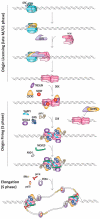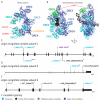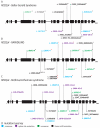Congenital Diseases of DNA Replication: Clinical Phenotypes and Molecular Mechanisms
- PMID: 33477564
- PMCID: PMC7831139
- DOI: 10.3390/ijms22020911
Congenital Diseases of DNA Replication: Clinical Phenotypes and Molecular Mechanisms
Abstract
Deoxyribonucleic acid (DNA) replication can be divided into three major steps: initiation, elongation and termination. Each time a human cell divides, these steps must be reiteratively carried out. Disruption of DNA replication can lead to genomic instability, with the accumulation of point mutations or larger chromosomal anomalies such as rearrangements. While cancer is the most common class of disease associated with genomic instability, several congenital diseases with dysfunctional DNA replication give rise to similar DNA alterations. In this review, we discuss all congenital diseases that arise from pathogenic variants in essential replication genes across the spectrum of aberrant replisome assembly, origin activation and DNA synthesis. For each of these conditions, we describe their clinical phenotypes as well as molecular studies aimed at determining the functional mechanisms of disease, including the assessment of genomic stability. By comparing and contrasting these diseases, we hope to illuminate how the disruption of DNA replication at distinct steps affects human health in a surprisingly cell-type-specific manner.
Keywords: Baller-Gerold syndrome; FILS syndrome; IMAGe syndrome; Meier-Gorlin syndrome; RAPADILINO; Rothmund-Thomson syndrome; Van Esch-O’Driscoll disease; X-linked pigmentary reticulate disorder; natural killer cell deficiency.
Conflict of interest statement
The authors declare no conflict of interest.
Figures













Similar articles
-
Human RecQL4 helicase plays multifaceted roles in the genomic stability of normal and cancer cells.Cancer Lett. 2018 Jan 28;413:1-10. doi: 10.1016/j.canlet.2017.10.021. Epub 2017 Nov 7. Cancer Lett. 2018. PMID: 29080750 Review.
-
The molecular role of the Rothmund-Thomson-, RAPADILINO- and Baller-Gerold-gene product, RECQL4: recent progress.Cell Mol Life Sci. 2007 Apr;64(7-8):796-802. doi: 10.1007/s00018-007-6468-5. Cell Mol Life Sci. 2007. PMID: 17364146 Free PMC article. Review.
-
RecQ family helicases in genome stability: lessons from gene disruption studies in DT40 cells.Cell Cycle. 2008 Aug 15;7(16):2472-8. doi: 10.4161/cc.7.16.6462. Epub 2008 Aug 18. Cell Cycle. 2008. PMID: 18719387 Review.
-
The versatile RECQL4.Genet Med. 2006 Apr;8(4):213-6. doi: 10.1097/01.gim.0000214457.58378.1a. Genet Med. 2006. PMID: 16617241 Review.
-
Search for ReCQL4 mutations in 39 patients genotyped for suspected Rothmund-Thomson/Baller-Gerold syndromes.Clin Genet. 2015 Mar;87(3):244-51. doi: 10.1111/cge.12361. Epub 2014 Mar 26. Clin Genet. 2015. PMID: 24635570
Cited by
-
Selective role of the DNA helicase Mcm5 in BMP retrograde signaling during Drosophila neuronal differentiation.PLoS Genet. 2022 Jun 23;18(6):e1010255. doi: 10.1371/journal.pgen.1010255. eCollection 2022 Jun. PLoS Genet. 2022. PMID: 35737938 Free PMC article.
-
Distinct roles of Arabidopsis ORC1 proteins in DNA replication and heterochromatic H3K27me1 deposition.Nat Commun. 2023 Mar 7;14(1):1270. doi: 10.1038/s41467-023-37024-8. Nat Commun. 2023. PMID: 36882445 Free PMC article.
-
Design, synthesis and evaluation of novel norfloxacin analogs as potent anticancer and antioxidant agents.Future Med Chem. 2024;16(17):1777-1789. doi: 10.1080/17568919.2024.2383165. Epub 2024 Aug 8. Future Med Chem. 2024. PMID: 39115052 Free PMC article.
-
Comprehensive analysis of DNA replication timing across 184 cell lines suggests a role for MCM10 in replication timing regulation.Hum Mol Genet. 2022 Aug 25;31(17):2899-2917. doi: 10.1093/hmg/ddac082. Hum Mol Genet. 2022. PMID: 35394024 Free PMC article.
-
Meier-Gorlin Syndrome: Clinical Misdiagnosis, Genetic Testing and Functional Analysis of ORC6 Mutations and the Development of a Prenatal Test.Int J Mol Sci. 2022 Aug 17;23(16):9234. doi: 10.3390/ijms23169234. Int J Mol Sci. 2022. PMID: 36012502 Free PMC article.
References
-
- Chandrasekaran S., Reidy T.K., Gowen J. Fundamental Aspects of DNA Replication. IntechOpen; London, UK: 2011. Regulation of DNA Replication Origin Licensing. - DOI
-
- Zhang J., Bellani M.A., James R.C., Pokharel D., Zhang Y., Reynolds J.J., McNee G.S., Jackson A.P., Stewart G.S., Seidman M.M. DONSON and FANCM associate with different replisomes distinguished by replication timing and chromatin domain. Nat. Commun. 2020;11:1–15. doi: 10.1038/s41467-020-17449-1. - DOI - PMC - PubMed
-
- Reynolds J.J., Bicknell L.S., Carroll P., Higgs M.R., Shaheen R., Murray J.E., Papadopoulos D.K., Leitch A., Murina O., Tarnauskaitė Ž., et al. Mutations in DONSON disrupt replication fork stability and cause microcephalic dwarfism. Nat. Genet. 2017;49:537–549. doi: 10.1038/ng.3790. - DOI - PMC - PubMed
Publication types
MeSH terms
Substances
Grants and funding
LinkOut - more resources
Full Text Sources
Other Literature Sources
Medical

